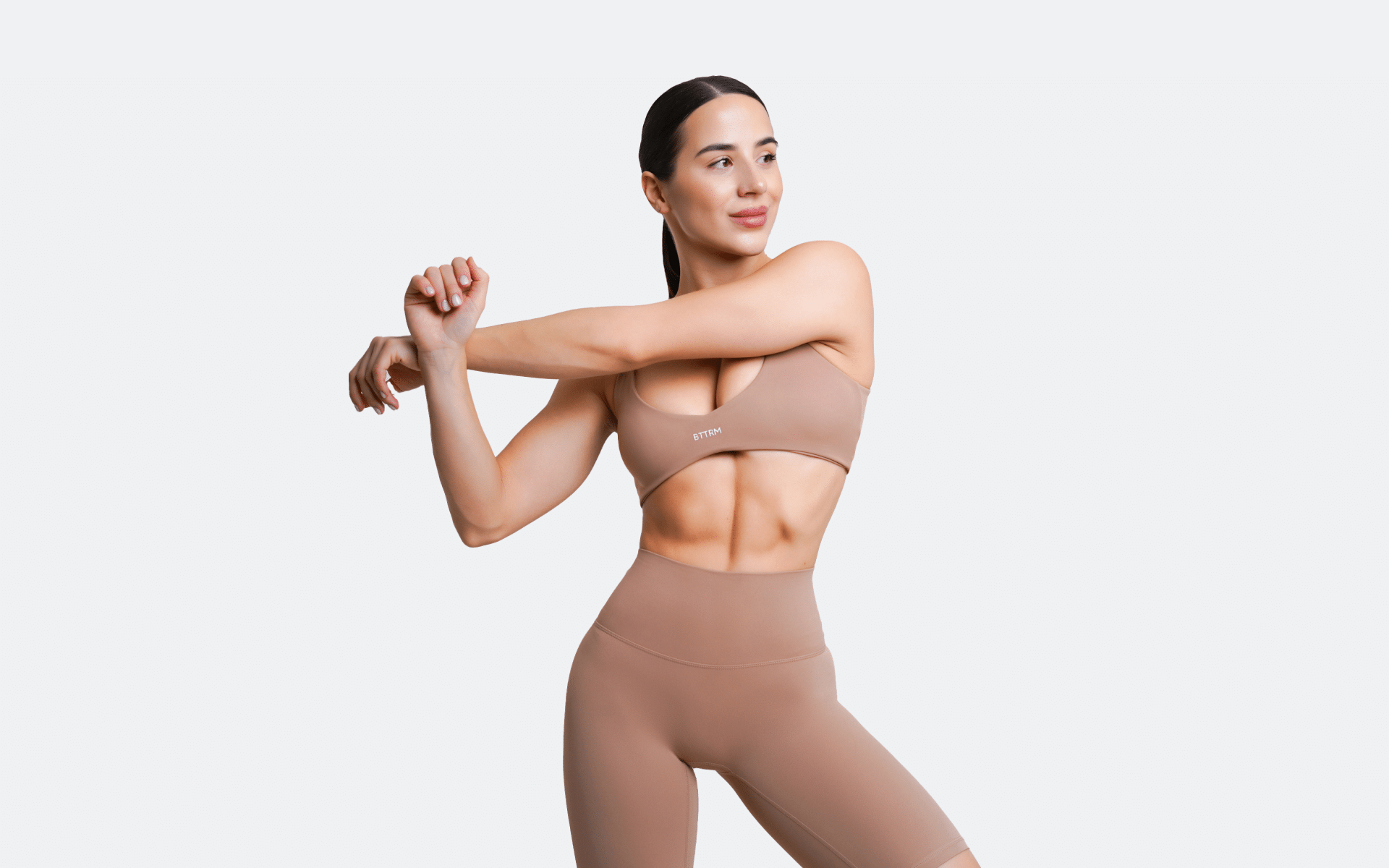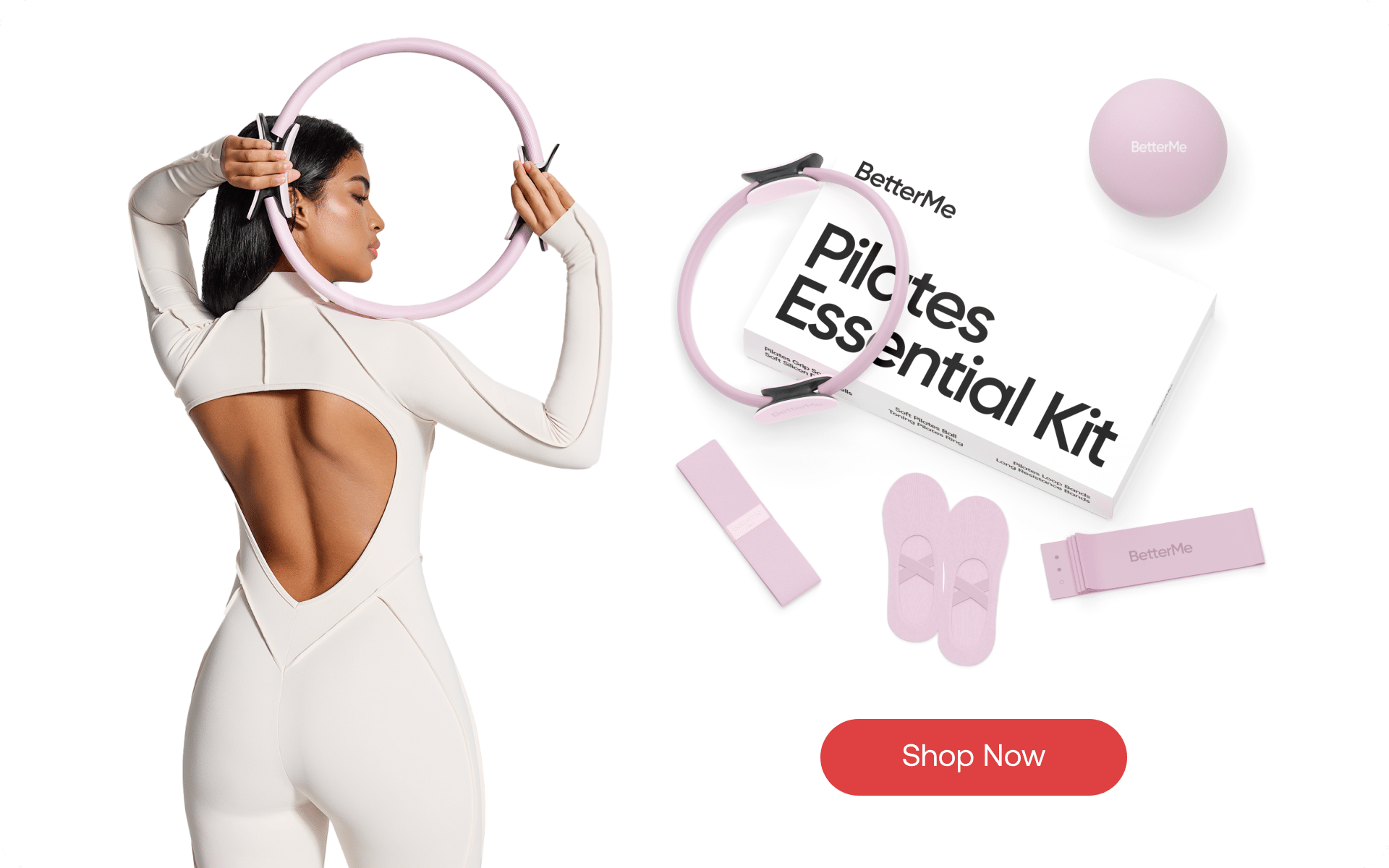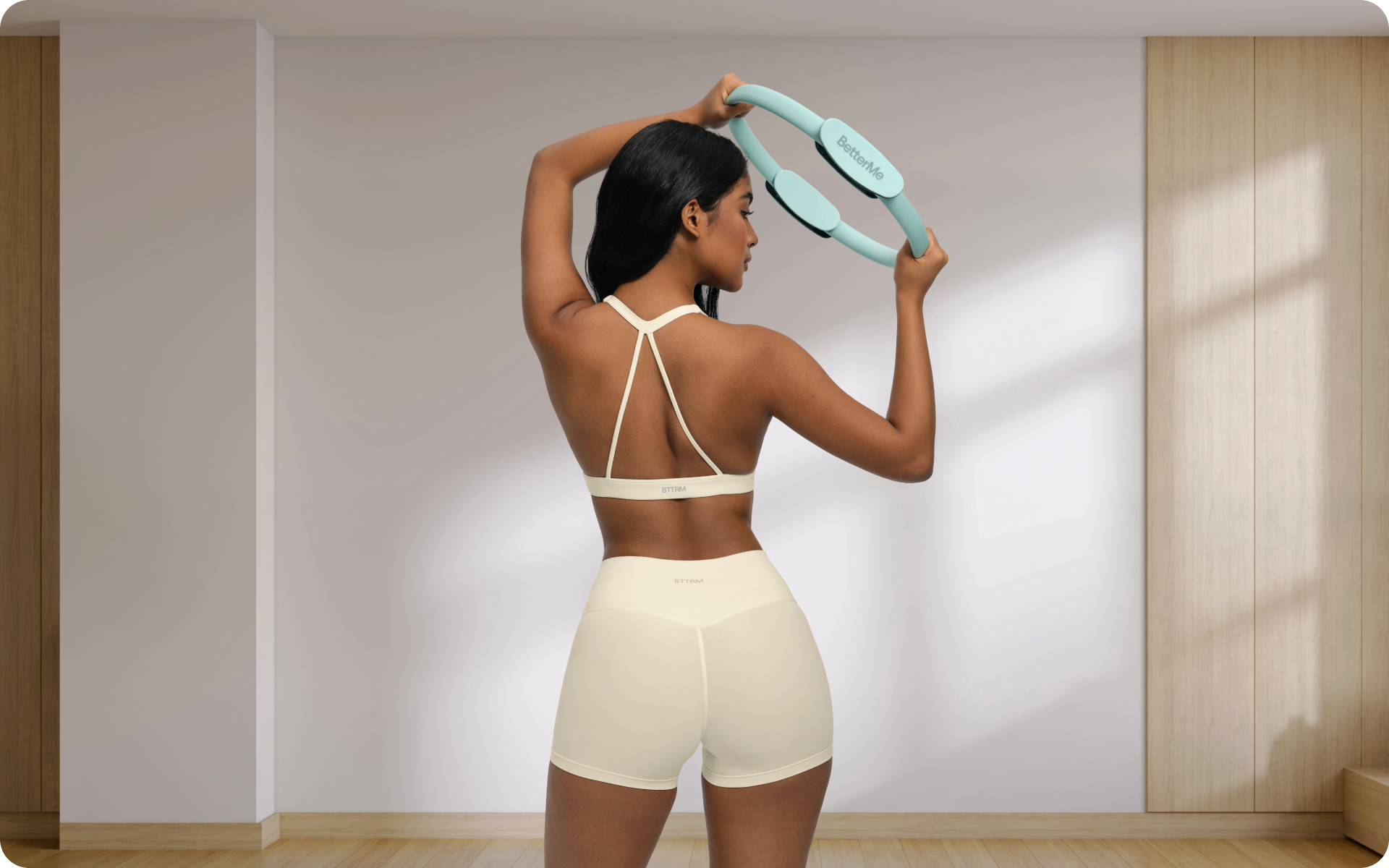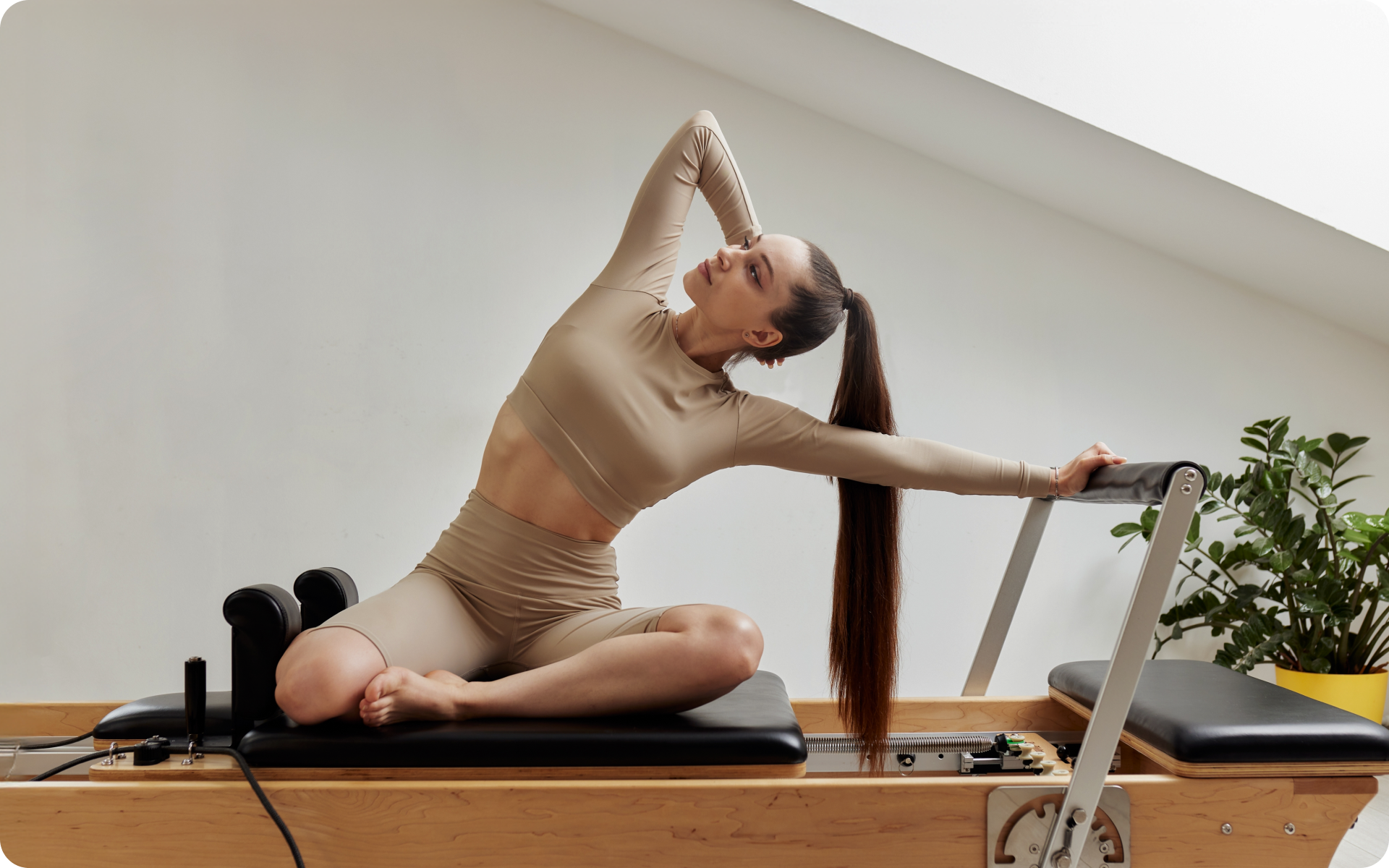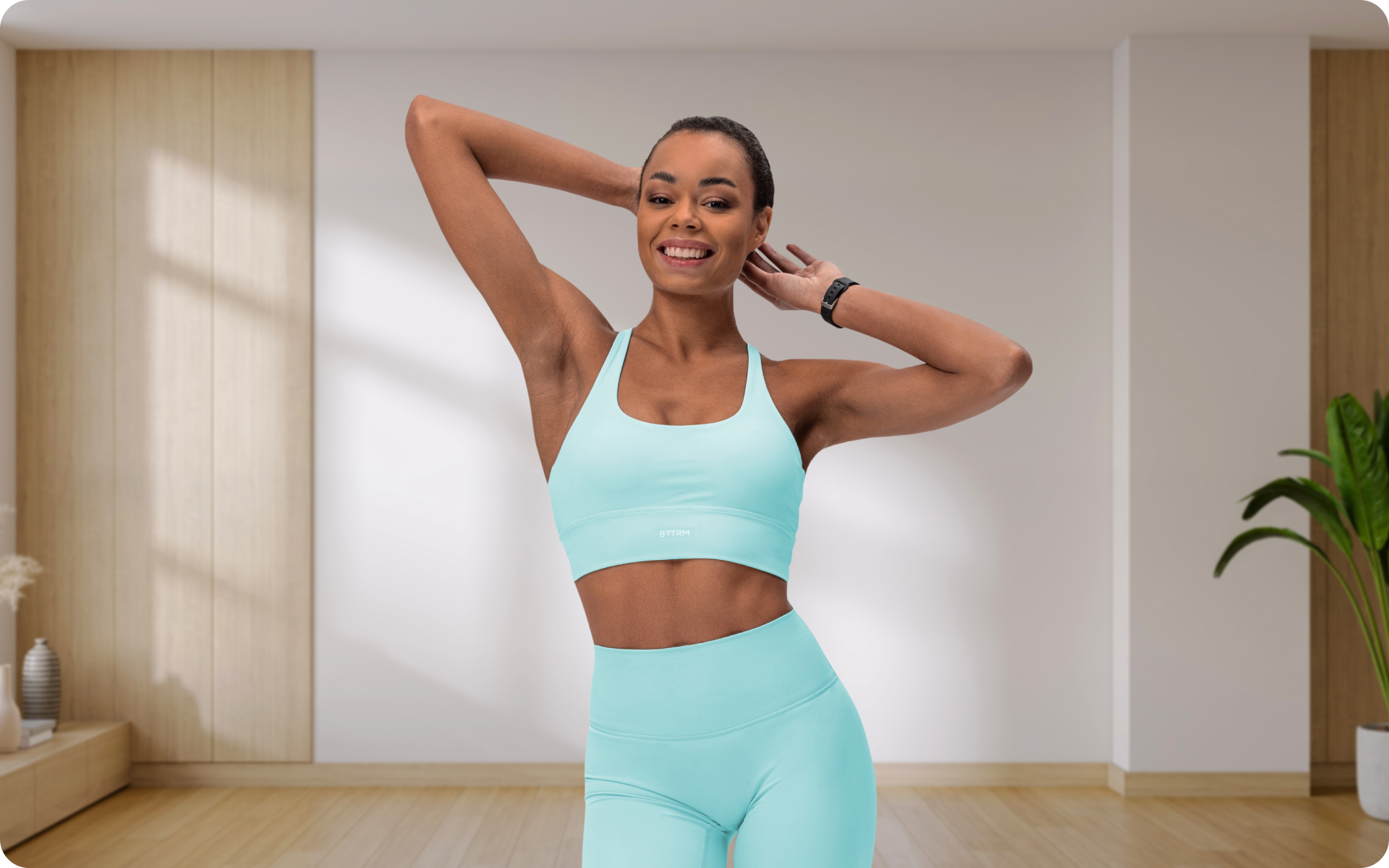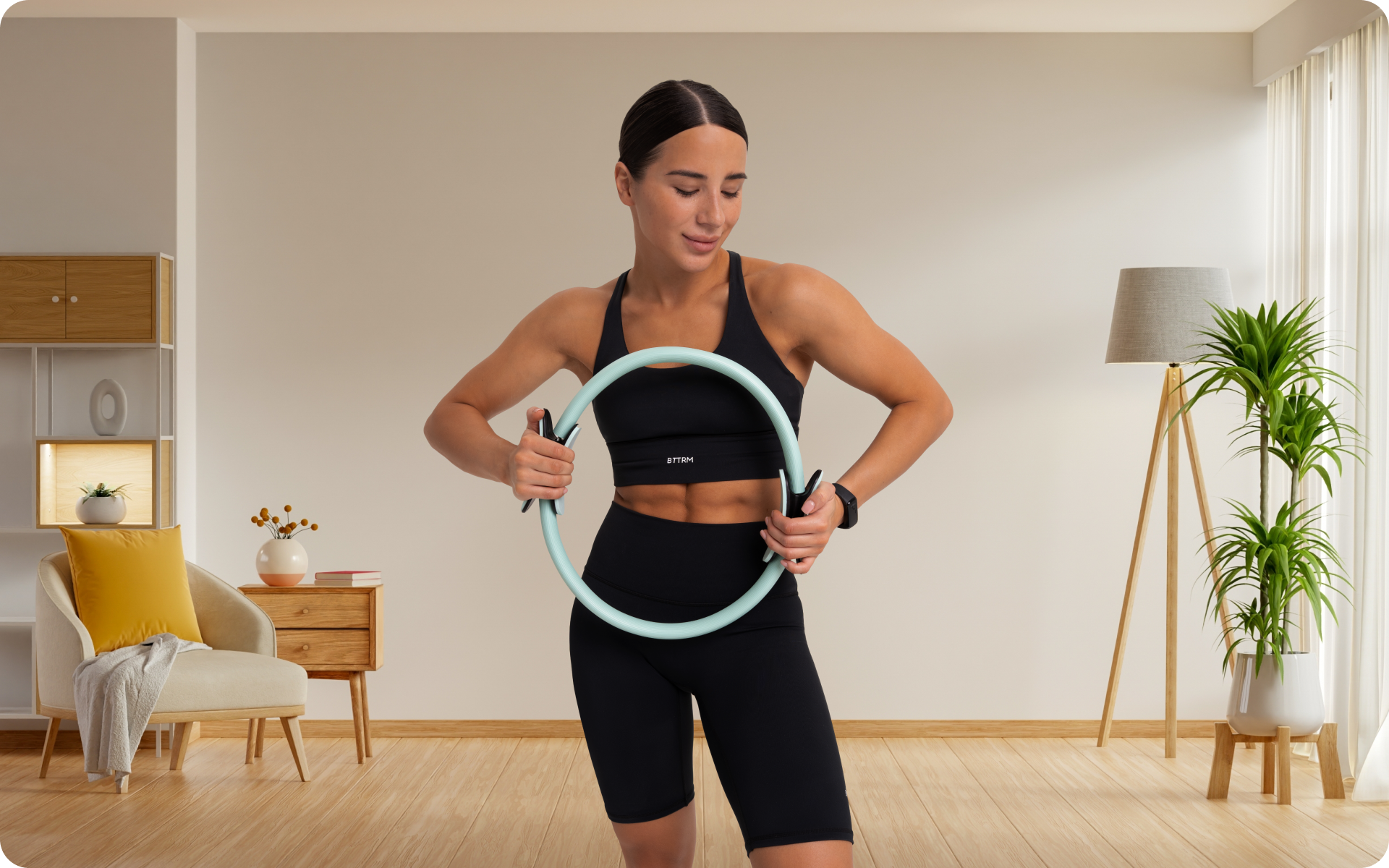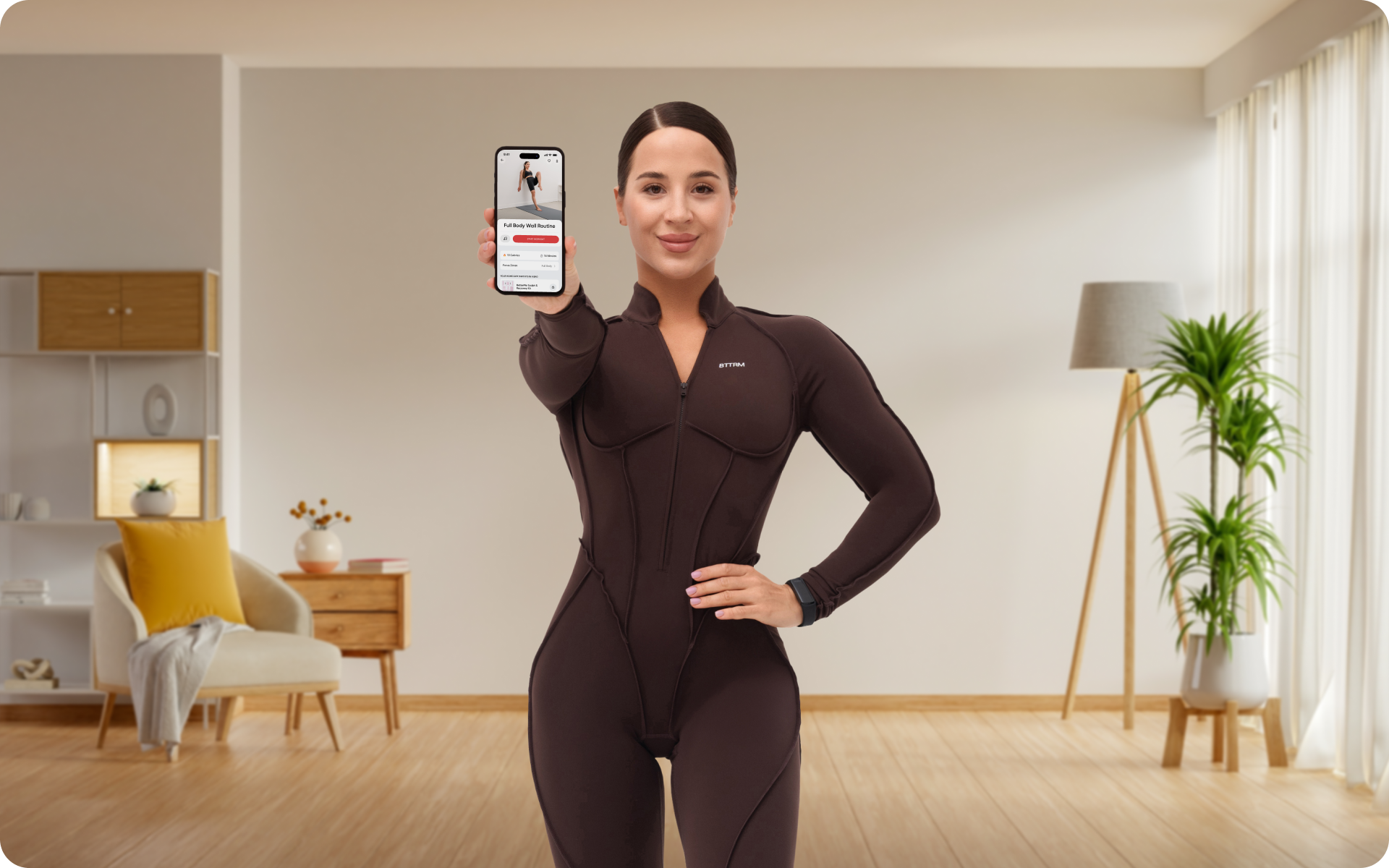This chair pilates guide explores the numerous benefits of this accessible and versatile workout, suitable for all fitness levels. Learn how this low-impact, full-body workout targets various muscle groups through a combination of Pilates exercises and chair exercises, designed to improve posture, flexibility, core strength, and balance. Whether you’re new to exercise or looking to diversify your routine, Chair Pilates offers a unique approach to building core strength and enhancing overall well-being.
Chair Pilates 101
When Joseph Pilates first developed his exercise system in the early 20th century, he could hardly have imagined how it would evolve and expand over the years. Originally designed as a rehabilitation program for injured soldiers during World War I, Pilates has grown into a popular fitness regimen practiced by millions around the world (9).
One of the most significant evolutions of this discipline is the introduction of Chair Pilates, making the practice more inclusive and accessible than ever before. In this article, we will dive into the world of Chair Pilates, answering all your questions and exploring value it can bring to people of all ages, abilities, and fitness levels.
What Is Chair Pilates?
Chair Pilates is an innovative adaptation of traditional Pilates that incorporates the use of a sturdy chair as a primary prop. This form of exercise is designed to cater to a diverse range of individuals, including those with mobility limitations or those seeking a fresh approach to their fitness routine.
Despite its modifications, Chair Pilates remains faithful to the core principles of the original method: concentration, control, centering, flow, precision, and breath.
The mechanics of Chair Pilates involve performing modified versions of classic Pilates exercises while seated or using the chair for support. The chair serves as a versatile tool that helps participants target various muscle groups while maintaining proper body alignment and posture.
The additional support and stability provided by the chair ensure a safe and comfortable workout experience.
By integrating the fundamental principles of Pilates with the practicality of using a chair, this form of exercise offers an accessible yet challenging workout for individuals of all ages, abilities, and fitness levels.
Chair Pilates focuses on building strength, balance, and flexibility through a series of carefully designed movements that engage the mind and body in unison.
Read More: 12 Office Chair Yoga Exercises For When You’ve Had A Long Day At Work

What Muscles Does Pilates Chair Work?
Pilates Chair, much like its traditional counterpart, is designed to work a comprehensive range of muscles throughout the body.
This innovative exercise method targets major muscle groups such as the core, upper body, and lower body, as well as smaller stabilizing muscles that contribute to overall strength, balance, and flexibility.
By engaging these muscles in various combinations, Chair Pilates offers a full-body workout that promotes functional movement and overall well-being.
Core Muscles
The core muscles, which include the rectus abdominis, obliques, and transverse abdominis, play a crucial role in maintaining stability and balance. Chair Pilates engages the core through exercises that involve controlled movements and deep abdominal contractions (2).
Strengthening the core muscles improves posture, reduces the risk of back pain, and enhances overall physical performance (3) (6).
Upper Body Muscles
Chair Pilates works the major upper body muscles, including the deltoids, trapezius, pectorals, and latissimus dorsi. Exercises such as seated arm circles, chest expansions, and seated rows target these muscles, helping to develop strength, endurance, and proper posture.
A strong upper body supports daily activities and reduces the likelihood of injury.
Lower Body Muscles
The glutes, quadriceps, hamstrings, and calves are all targeted during Chair Pilates workouts.
Exercises like seated leg lifts, chair squats, and seated bicycle movements help to build lower body strength, improve balance, and increase flexibility. Strong lower body muscles contribute to better mobility, support for the spine, and reduced risk of injury.
Stabilizing Muscles
Chair Pilates also engages the smaller stabilizing muscles that are often overlooked in traditional workouts. These muscles, plus those surrounding the hips, shoulders, and spine, are vital for maintaining balance and proper body alignment.
By incorporating exercises that challenge these muscles, Chair Pilates promotes overall stability and reduces the risk of injuries associated with muscle imbalances.
Looking for a way to break the vicious cycle of weight loss and tone up all the jiggly parts? Watch the extra pounds fly off and your muscles firm up with the BetterMe app!

What Are The Benefits Of Chair Pilates?
Chair Pilates, just like traditional pilates, offers a wide range of physical and mental health benefits (7) (8). This form of exercise helps with:
1. Improved Posture
Chair Pilates helps strengthen the muscles responsible for maintaining proper alignment, particularly those in the core and upper back.
As a result, practitioners often experience improved posture, which can alleviate discomfort caused by poor alignment and reduce the risk of developing chronic pain or injuries.
2. Increased Flexibility
Through its gentle, controlled movements and stretches, Chair Pilates works to lengthen and loosen muscles, increasing overall flexibility.
Enhanced flexibility not only improves joint mobility and range of motion but also reduces the likelihood of injury during daily activities or other exercises (5).
3. Enhanced Core Strength
Core muscles are engaged throughout a Chair Pilates workout, resulting in increased strength and stability in the abdomen, lower back, and pelvic regions (2). A strong core contributes to better balance, a reduced risk of back pain, and improved overall physical performance (3).
4. Greater Balance And Stability
By targeting both major and minor muscle groups, including stabilizing muscles, Chair Pilates helps to improve balance and stability. This is particularly beneficial for older adults or individuals with limited mobility, as it can reduce the risk of falls and injuries (1).
5. Accessible Exercise Option
The use of a chair makes Pilates more accessible for people of all ages, fitness levels, and physical abilities.
Individuals with mobility limitations, injuries, or chronic conditions can still reap the numerous benefits of Pilates without the need for extensive modifications or specialized equipment.
6. Reduced Stress And Anxiety
Chair Pilates emphasizes mindful movement and deep breathing techniques, which can help reduce stress and anxiety.
By focusing on the present moment and connecting the mind and body, practitioners often experience a sense of calm and relaxation during and after their workouts.
Read More: Unlocking Relaxation: The Magic Of Restorative Chair Yoga

7. Low-Impact Workout
As a low-impact form of exercise, chair Pilates is gentle on the joints, making it an ideal choice for individuals with joint pain or conditions like arthritis. The controlled movements and supportive nature of the chair help minimize possible strain while still providing an effective workout.
8. Enhanced Body Awareness
Chair Pilates encourages practitioners to focus on their body’s alignment, movement patterns, and muscle activation. This heightened body awareness can lead to better posture, improved movement efficiency, and reduced risk of injury in daily life and other physical activities.
How To Do Chair Pilates At Home?
To do chair Pilates at Home, you must find a dedicated space for your practice. Gather any necessary props, including a mat, Pilates chair (or sturdy chair), and other pieces of equipment you may need (such as light weights or a resistance band).
Once you have gathered your supplies, you can begin your Pilates routine by warming up and following the steps below:
1. Choose A Suitable Space
Select a quiet, well-lit area in your home with enough space for you to move comfortably while seated on a chair. Ensure that the floor is level and free of any obstructions.
2. Gather The Necessary Equipment
You’ll need a sturdy, armless chair with a flat seat and a non-slip surface. A yoga mat or cushion can be used for added comfort, and small props like a Pilates ring or resistance band may be incorporated for more advanced exercises.
3. Warm Up
Begin your chair Pilates workout with a gentle warm-up to prepare your body for the exercises ahead (10). This can include simple stretches, deep breathing exercises, or light movements to increase circulation and loosen up your muscles.
4. Plan Your Routine
Compile a list of Pilates chair exercises that target various muscle groups and cater to your specific fitness goals. There are numerous resources available online, including chair Pilates for beginners, gentle chair Pilates routines, and more advanced workouts.
Be sure to include a mix of strengthening, stretching, and balance exercises for a well-rounded session.
If you tend to let yourself off the hook, raise the white flag when things get tougher than you expected, send yourself on an unconscious binge-eating trip – BetterMe app is here to help you leave all of these sabotaging habits in the past!
5. Perform The Exercises With Proper Form
As you work through your chosen Pilates chair exercise list, focus on maintaining proper alignment and executing each movement with control and precision. Remember to breathe deeply and engage your core throughout the workout.
6. Cool Down
Conclude your chair Pilates session with a series of gentle stretches and relaxation exercises to help your body recover and transition back to a state of rest (4).
7. Stay Consistent
Aim to incorporate Chair Pilates into your fitness routine on a regular basis, ideally 2-3 times per week, to experience the full range of benefits and see noticeable improvements in strength, flexibility, and balance.
Pilates Chair Exercise List, With Instructions
Here is a list of Pilates Chair exercises, complete with step-by-step instructions to help you get started:
Seated Marches
To do it:
- Sit up tall on the edge of the chair with your feet flat on the floor, hip-width apart.
- Engage your core and maintain a neutral spine throughout the exercise.
- Slowly lift your right knee towards your chest, keeping your foot flexed.
- Lower your right foot back to the floor and repeat with your left knee.
- Continue alternating legs for 10-12 repetitions on each side.
Seated Leg Lifts
To do it:
- Sit up tall on the edge of the chair with your feet flat on the floor, hip-width apart.
- Straighten your right leg out in front of you, keeping your foot flexed and toes pointed upward.
- Engage your core and lift your right leg as high as comfortably possible without compromising your posture.
- Lower your leg back down to just above the floor and repeat for 10-12 repetitions.
- Switch legs and perform the same number of repetitions on the left side.
Seated Arm Circles
To do it:
- Sit up tall in the middle of the chair with your feet flat on the floor, hip-width apart.
- Extend your arms out to the sides at shoulder height, palms facing down.
- Engage your core and make small circles with your arms, moving them forward for 10-12 repetitions.
- Reverse the direction of the circles, moving your arms backward for an additional 10-12 repetitions.
Spine Twist
To do it:
- Sit up tall on the edge of the chair with your feet flat on the floor, hip-width apart.
- Place your hands behind your head with your elbows pointing outward.
- Inhale deeply, and as you exhale, rotate your upper body to the right, keeping your hips and lower body stable.
- Inhale as you return to the center, and then exhale as you rotate to the left.
- Continue alternating sides for a total of 8-10 repetitions on each side.
Chair Squats
To do it:
- Stand in front of the chair with your feet hip-width apart, facing away from the chair.
- Keep your arms extended in front of you at shoulder height or place them on your hips.
- Engage your core and slowly lower your hips towards the chair, bending at the knees and pushing your weight into your heels.
- Lower yourself until your glutes are just above the chair, maintaining a neutral spine and keeping your chest lifted.
- Press through your heels and straighten your legs to return to a standing position.
- Repeat for 10-12 repetitions.
Seated Bicycle
To do it:
- Sit on the edge of the chair, leaning slightly back and holding onto the sides of the chair for support.
- Lift both feet off the floor and bend your knees, bringing them towards your chest.
- Engage your core and extend your right leg straight out in front of you while drawing your left knee closer to your chest.
- Switch legs by extending your left leg and drawing your right knee towards your chest.
- Continue alternating legs for a total of 10-12 repetitions on each side.
Seated Scissor Legs
To do it:
- Sit up tall on the edge of the chair with your feet flat on the floor, hip-width apart.
- Hold onto the sides of the chair for support and lean slightly back.
- Lift both legs off the floor and straighten them as much as possible, keeping your toes pointed.
- Engage your core and lower your right leg towards the floor while keeping your left leg raised.
- Switch legs by raising your right leg and lowering your left leg.
- Continue alternating legs for a total of 10-12 repetitions on each side.
Seated Single Leg Stretch
To do it:
- Sit up tall on the edge of the chair with your feet flat on the floor, hip-width apart.
- Place your hands behind your head, elbows pointing outward.
- Engage your core and lift your right knee towards your chest while simultaneously rotating your upper body to bring your left elbow towards the right knee.
- Return to the starting position and repeat on the other side, bringing your right elbow towards your left knee.
- Continue alternating sides for a total of 10-12 repetitions on each side.
Seated Roll-Down
To do it:
- Sit up tall in the middle of the chair with your feet flat on the floor, hip-width apart.
- Place your hands on your thighs or hold onto the sides of the chair for support.
- Engage your core and slowly roll down through your spine, starting at the neck and moving towards the base of your spine.
- Keep your abdominals engaged as you roll back up to the starting position, one vertebra at a time.
- Repeat for 5-8 repetitions.
Seated Side Bend
To do it:
- Sit up tall on the edge of the chair with your feet flat on the floor, hip-width apart.
- Extend your right arm overhead with your palm facing inward.
- Engage your core and gently bend your upper body to the left, reaching your right arm over your head to create a “C” curve with your spine.
- Hold the stretch for a few seconds before returning to the starting position.
- Repeat on the other side with your left arm extended overhead.
- Continue alternating sides for a total of 8-10 repetitions on each side.
Seated Leg Circles
To do it:
- Sit up tall on the edge of the chair with your feet flat on the floor, hip-width apart.
- Straighten your right leg out in front of you, keeping your foot flexed and toes pointing upward.
- Engage your core and draw small circles in the air with your right leg, moving clockwise for 10-12 repetitions.
- Reverse the direction of the circles, moving counterclockwise for an additional 10-12 repetitions.
- Switch legs and perform the same number of repetitions on the left side.
The Bottom Line
Chair Pilates offers a versatile and accessible approach to the traditional Pilates method, making it an ideal choice for individuals of all ages, fitness levels, and abilities.
By incorporating a variety of exercises that target different muscle groups, Chair Pilates helps improve posture, flexibility, core strength, balance, and overall well-being.
With the guidance provided in this article, you may confidently embark on your own Chair Pilates journey and enjoy the numerous benefits this unique exercise method has to offer.
DISCLAIMER:
This article is intended for general informational purposes only and does not serve to address individual circumstances. It is not a substitute for professional advice or help and should not be relied on for making any kind of decision-making. Any action taken as a direct or indirect result of the information in this article is entirely at your own risk and is your sole responsibility.
BetterMe, its content staff, and its medical advisors accept no responsibility for inaccuracies, errors, misstatements, inconsistencies, or omissions and specifically disclaim any liability, loss or risk, personal, professional or otherwise, which may be incurred as a consequence, directly or indirectly, of the use and/or application of any content.
You should always seek the advice of your physician or other qualified health provider with any questions you may have regarding a medical condition or your specific situation. Never disregard professional medical advice or delay seeking it because of BetterMe content. If you suspect or think you may have a medical emergency, call your doctor.
SOURCES:
- Benefits of Pilates in the Elderly Population: A Systematic Review and Meta-Analysis (2022, mdpi.com)
- Co-contraction of the core muscles during Pilates exercise on the Wunda Chair (2020, pubmed.ncbi.nlm.nih.gov)
- Core Stability Exercise Principles (2008, journals.lww.com)
- Do We Need a Cool-Down After Exercise? A Narrative Review of the Psychophysiological Effects and the Effects on Performance, Injuries and the Long-Term Adaptive Response (2018, link.springer.com)
- Flexibility and its effects on sports injury and performance (1997, pubmed.ncbi.nlm.nih.gov)
- Optimizing performance by improving core stability and core strength (2008, pubmed.ncbi.nlm.nih.gov)
- Pilates (2011, ncbi.nlm.nih.gov)
- Pilates: how does it work and who needs it? (2011, ncbi.nlm.nih.gov)
- The History of Pilates (n.d., pilatesfoundation.com)
- Warm-Up Strategies for Sport and Exercise: Mechanisms and Applications (2015, pubmed.ncbi.nlm.nih.gov)
